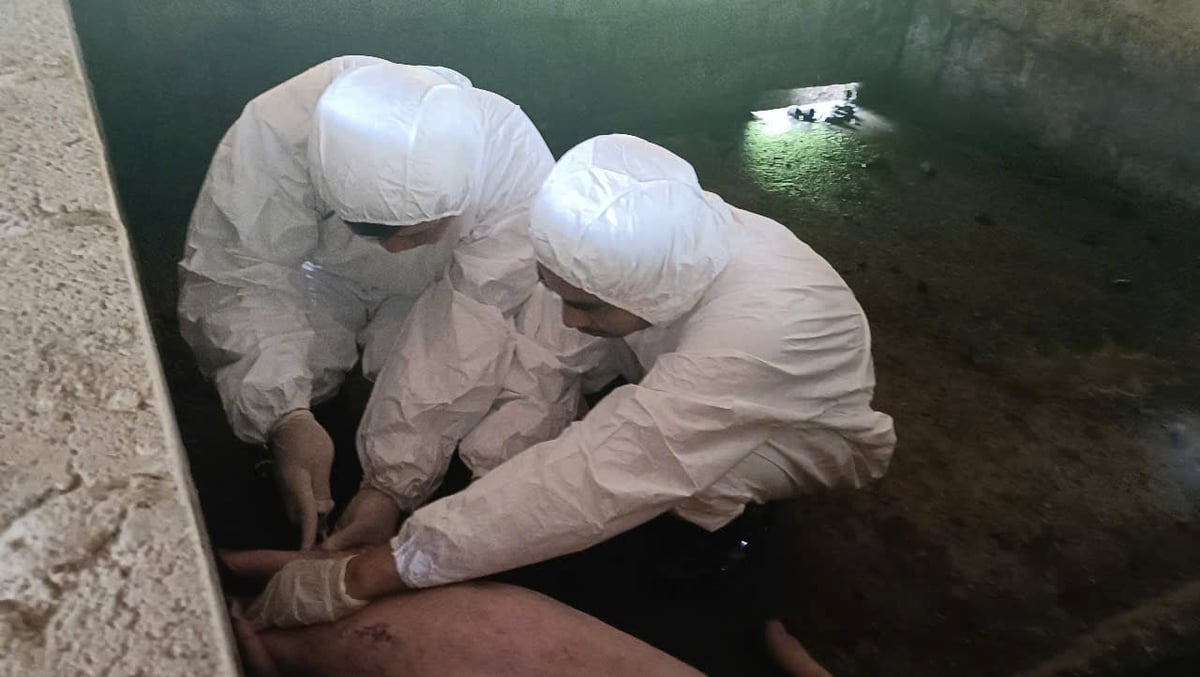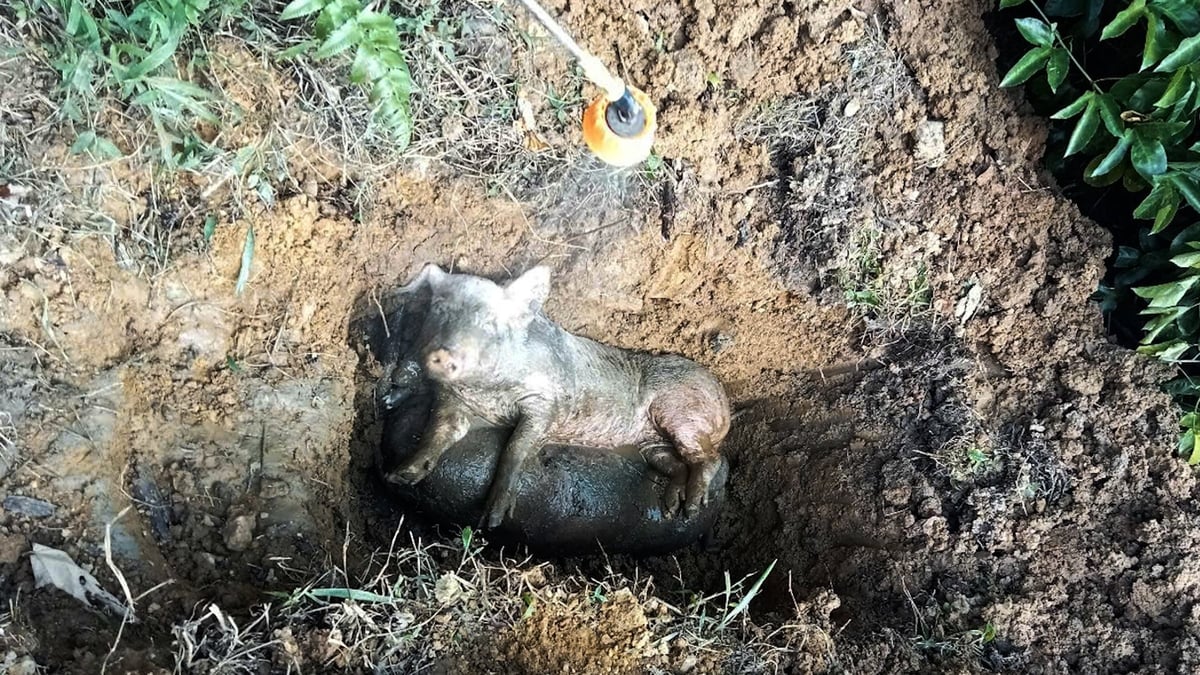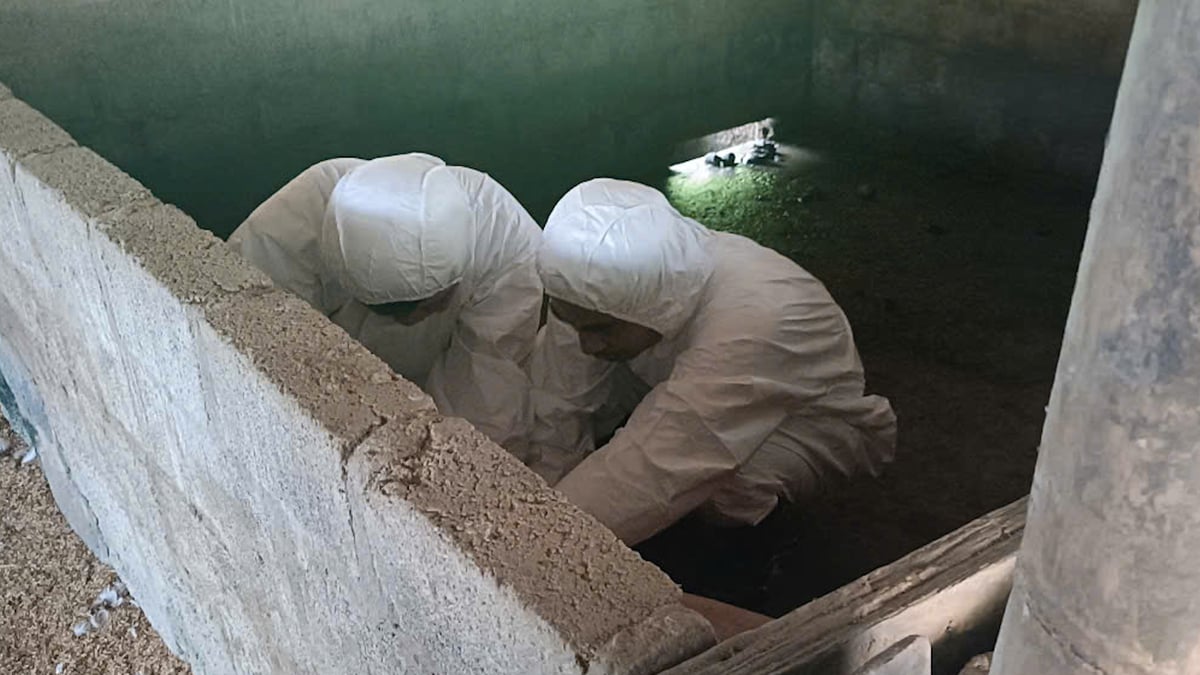December 30, 2025 | 15:56 GMT +7
December 30, 2025 | 15:56 GMT +7
Hotline: 0913.378.918
December 30, 2025 | 15:56 GMT +7
Hotline: 0913.378.918
Since the beginning of 2025, African swine fever has shown complicated developments in many localities across Vietnam. According to statistics, in the first six months of 2025, approximately 400 outbreaks were recorded in provinces and cities, destroying more than 22,000 pigs. Although the scale is not large, outbreaks occur sporadically and persist for an extended period, particularly on small-scale farms.

Professional staff inspect and handle an outbreak of African swine fever in Yen Phong commune, Thai Nguyen province. Photo: Ngoc Tu.
The risk of African swine fever outbreaks in mountainous communes of northern Thai Nguyen province (formerly Bac Kan province) is higher than ever. Farmers in this area primarily raise livestock on a small scale, often under poor and inadequate sanitation and disinfection conditions. Sick and dead pigs suspected of being infected with dangerous diseases have appeared as a result. Although a large-scale outbreak has not been announced, the epidemiological factors are showing clear signs.
“In coordination with specialized agencies, Yen Phong commune has sent officials to each village to grasp the situation and guide people on disease prevention and control measures. As for sick and dead pigs, the commune has mobilized personnel to support farmers and immediately destroy them as per regulations,” said Chu Van Trieu, Chairman of Yen Phong Commune People's Committee.
Information from Thai Nguyen Department of Agriculture and Environment shows that the epidemic has appeared in 8 communes and wards since July 1, including Thuong Quan, Yen Phong, Ngan Son, Cuong Loi, Dan Tien, Binh Yen, Bang Van and Bach Quang.
As of July 13, the number of sick pigs that had to be destroyed was 384, equivalent to more than 18 tons. Local authorities took samples of some outbreaks for testing, and the results were positive for the African swine fever virus.
Compared to neighboring provinces such as Cao Bang and Lang Son (where widespread outbreaks have been reported), the extent of damage caused by African swine fever in Thai Nguyen is still at the early warning stage. However, the risk of an outbreak is relatively high due to the favorable trade between these localities. Many livestock farmers are still not fully aware of the danger of the disease, and even show signs of concealment when their pigs are sick or dead.
One thing to note is that the management of animal and pig product transportation remains a weak link. The routes connecting Lang Son and Cao Bang to Thai Nguyen still lack inter-sectoral quarantine checkpoints. The trading of breeding pigs and pork of unknown origin at traditional markets, small collection and slaughter facilities still occurs, posing a potential risk of spreading pathogens.
The recent change of the governmental structure has caused the veterinary force in some communes and wards to be thinned out. There are not enough human resources to closely monitor disease developments in livestock households, not to mention the untimely updates on outbreaks and investigations of clinical signs.

Destroying dead pigs in Yen Phong commune, Thai Nguyen province. Photo: Ngoc Tu.
Facing the risk of African swine fever spreading, the authorities and specialized agencies in Thai Nguyen have taken urgent and synchronous actions. The provincial Department of Agriculture and Environment has issued an official dispatch requesting that the entire political system strongly participate and implement preventive measures according to regulations.
Thai Nguyen Department of Agriculture and Environment has established two working groups consisting of 73 highly qualified and experienced officials to handle outbreaks in communes and wards. Working group 1 supports epidemic prevention and control in 37 northern communes. Working group 2 supports epidemic prevention and control in 55 southern communes. The working groups directly go to communes to inspect farms, collect samples for testing and instruct farmers on how to handle outbreaks.
Dinh Thi Hong Chiem, Head of Thai Nguyen Sub-Department of Livestock Production, Animal Health and Fisheries of Thai Nguyen province, said, "The unit is actively inspecting and urging localities to strictly implement regulations on prevention and control of African swine fever, including conditions for herd restoration, herd expansion, and biosecurity in farming. We will strengthen inspection and monitoring of disease situations in livestock and poultry, promptly grasp the epidemic situation in neighboring provinces for timely response."

Professional staff of Thai Nguyen province were sent to communes to help people prevent epidemics. Photo: Quang Linh.
People were widely informed about the "5 no's" principle in disease prevention: no hiding the disease, no buying and selling sick pigs, no slaughtering sick pigs, no littering pig carcasses, and no using unheated leftover food. Bach Quang ward assigned specific tasks to units, developing response plans before, during, and after the outbreak of the epidemic.
Translated by Samuel Pham

(VAN) From extensive shrimp ponds, baskets of don gathered on the mudflats, to boats carrying visitors to watch birds, all livelihoods here depend on clean water, green forests, and the calls of migratory birds.
/2025/12/26/0703-3-204813_117.jpg)
(VAN) Transparency in information and listening to local people have helped address ground clearance bottlenecks and build social consensus, thereby accelerating the progress of the JICA3 irrigation project.
/2025/12/27/0609-3-233846_327.jpg)
(VAN) The JICA3 project is expected to become a 'water shield,' helping control saltwater intrusion, proactively secure water resources, protect livelihoods, and promote sustainable development in coastal areas.
/2025/12/26/5654-3-164509_655.jpg)
(VAN) As Viet Nam makes strong commitments toward achieving net-zero emissions, controlling and reducing methane emissions in livestock production is increasingly becoming a mandatory requirement.

(VAN) 'People, Primates, Plants: Co-managing Biodiversity and Improving Livelihoods in Vietnam' (the PPP Project) is an international initiative implemented in Vietnam by BGCI, CEGORN, and ICRAF/World Agroforestry.

(VAN) Dak Nong established a risk-level zoning map for coffee, built a digital data platform for the sector, and promoted certified production in line with EUDR.
/2025/12/25/2709-1-211551_295.jpg)
(VAN) In response to the U.S. Marine Mammal Protection Act (MMPA), Gia Lai province is implementing many solutions to protect marine mammals and develop sustainable, responsible fisheries.